Implantable Pacemaker
What is a pacemaker?
- A pacemaker (artificial pacemaker) is a medical device which uses electrical impulses, delivered by electrodes contracting the heart muscles, to regulate the beating of the heart.
- The primary purpose of a pacemaker is to maintain an adequate heart rate, either:
- Because the hearts natural pacemaker (the SA node) is not fast enough.
- Because there is a block in the hearts electrical conduction system.
- In modern pacemakers, cardiologist can externally program and select the optimum pacing modes for individual patients.
- Some combine a pacemaker and defibrillator in a single implantable device. It could have multiple electrodes stimulating differing positions within the heart.
Pacemaker are usually used:
- When a patient has a permanent or temporary slower than normal impulse formation.
- When a symptomatic AV or ventricular conduction disturbance.
- To control some tachydysrhythmias that do not response to medication.

Temporary pacemaker
- For short-term use during hospitalization to support patients until they improve or reserve a Permanent pacemakers.
- The Epicardial /Endocardial wires may be Temporary.
- Located outside the body (may be taped to the skin or attached to a belt or to the patients bed).
- The Temporary generator size is much bigger than permanent (about the size of a small paperback book).
Permanent pacemaker
- For long-term use.
- Endocardial leads.
- The generator implanted in a subcutaneous pocket.
- They last approximately 5 to 12 years.
- The permanent generator weighs less than 1 oz (28.3 g) and is the size of a thick credit card.
This is a basic pacemaker

Implantable Pacemaker Systems Contain the Following Components:
- Pulse generator: power source or battery
- Leads (wires)
- Electrode
- Cathode (negative electrode)
- Anode (positive electrode)
- Electrode
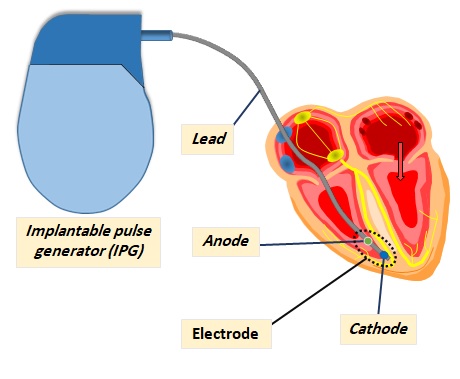
The Pulse Generator:
- Connector: interface between leads and pulse generator.
- Houses of circuitry: controls pacemaker operations that contains Microprocessors (both ROM and RAM) control sensing, output, telemetry and diagnostic circuits.
- Battery(power source): provides the energy for sending electrical impulses to the heart. Lithium-iodine is the most commonly used power source for todays pacemakers.
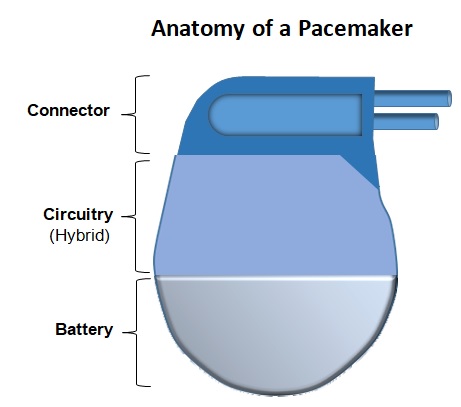
Leads:
- Insulated Wires that deliver electrical impulses from the pulse generator to the heart.
- Sense cardiac depolarization.
- Also transmit electrical signals from the heart to the pulse generator.
Pacing Lead Components:
- Conductor
- Connector Pin
- Insulation
- Electrode

- Electrode—a conductor located at the end of the lead; delivers the impulse to the heart.
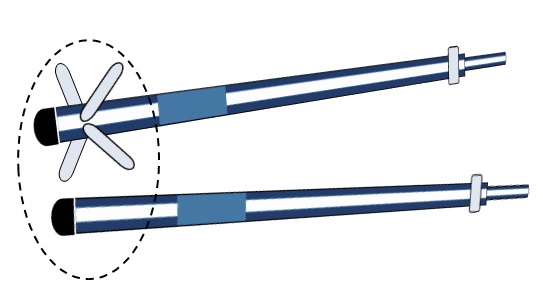
During Pacing, the Impulse:
- Begins in the pulse generator
- Flows through the lead and the cathode (–)
- Stimulates the heart
- Returns to the anode (+)
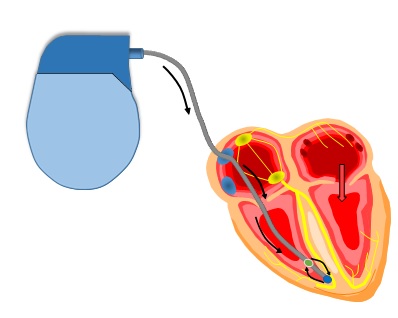
Pacing Systems
A Unipolar Pacing System Contains a Lead with Only One Electrode Within the Heart
In this system, the Impulse:
- Flows through the tip electrode (cathode)
- Stimulates the heart
- Returns through body fluid and tissue to the IPG (anode)
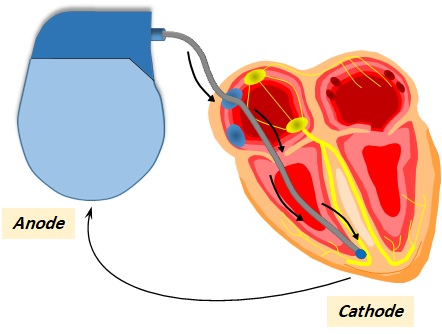
A Bipolar Pacing System Contains a Lead with Two Electrodes Within the Heart
In this system, the Impulse:
- Flows through the tip electrode located at the end of the lead wire (cathode)
- Stimulates the heart
- Returns to the ring electrode above the lead tip (anode)
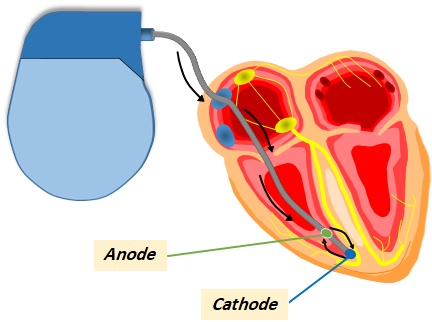
Most Pacemakers Perform Four Functions:
- Stimulate cardiac depolarization
- Sense intrinsic cardiac function (capture depolarization of atria and/or ventricles in response to a pacing stimulus)
- Respond to increased metabolic demand by providing rate responsive pacing
- Provide diagnostic information stored by the pacemaker
NBG Code
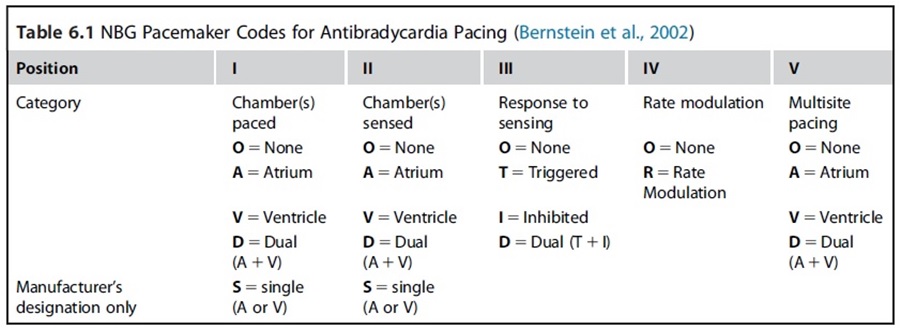
- Positions I and II indicate which chambers are to be paced and sensed.
- Position III relates to whether a pacing stimulus is either triggered or inhibited in response to a sensed cardiac depolarization.
- Position IV is used to determine whether the pacing rate can be automatically modulated (adjusted) by the pacemaker. The pacemaker can be configured for adaptive pacing to detect physiological parameters related to respiratory, body movement, temperature, oxygen saturation, and pH in the blood, in response to exercise such that the heart rate can be increased in order to cope with the extra physiological demands.
- Position V indicates whether multisite pacing is available in one or more of the chambers (Cardiac Resynchronization Therapy).
Examples of pacemaker settings:
- AOO—Atrial asynchronous pacemaker.
- Pace in atria, no chamber sensing. Atrial pacing at a fixed rate that is independent of the inherent heart rate.
- VOO—Ventricle asynchronous pacemaker.
- Pace in ventricle, no chamber sensing.
- Ventricular pacing at a fixed rate that is independent of the inherent heart rate.
- AAI—Atrial single chamber synchronous pacemaker.
- Pace in atrium and sense in atrium.
- Atrium pacing inhibited in response to atrium activity.
- VVI—Ventricular single chamber synchronous pacemaker.
- Pace in ventricle and sense in ventricle.
- Ventricular pacing inhibited in response to sensing ventricular activity.
- VDD—Ventricular dual chamber synchronous pacemaker.
- Pace in ventricle and sense in both atrial and ventricle.
- Ventricular pacing is triggered or inhibited in response to sensed atrial and ventricular activity.
- Sensed atrial activity will trigger ventricle pacing.However, a sensed ventricular activity will inhibit ventricular pacing.
- DVI—Dual chamber ventricle pacing sequential pacemaker.
- Pace in atrium and ventricle and sense in ventricle.
- Sensed atrial activity triggers a sequence of atrial stimulation, adjustable PR
- interval, and ventricular stimulation.
- Ventricle pacing is inhibited in response to ventricular activity.
- DDD—Dual chamber pacemaker.
- Pace in both atrium and ventricle, sense in both atrium and ventricle.
- Atrium and ventricle pacing inhibited in response to sensing atrial or ventricular activity.
- Atrium pacing inhibited in response to atriumactivity.
- Trigger ventricular pacing if atria activity is sensed unlessventricular activity is sensed.
- VVIRV—Biventricular rate-responsive pacemaker.
- Pace in ventricle, sense in ventricle. Ventricular pacing inhibited in
- response to sensing ventricular activity.
- Automatic rate modulation isenabled and employs multisite ventricular pacing.
- Other rate-responsive pacemakers include AAIR, DDIR, and DDDR.
Types of pacemakers (depends on chamber)
Single Chamber Pacing
- They have only one insulated lead to carry impulses to the heart.
- Either attached to the right atrium or to the right ventricle.
Dual Chamber Pacing
- They have two leads that help the heart to function in a natural way depending on the human body activity.
- One attached to the right atrium and the other to right ventricle.
Triple (Biventricular) Chamber Pacing
- They have three leads and specially designed for patients who have very weak heart muscles; hence they help in the contraction of the heart to produce a normal heart beat.
- One to the right atrium and right ventricle and the other to the left ventricle.
.jpg)
Each of the mentioned pacemakers are available in three different varieties
On Demand Pacemakers
- It monitors the heart’s natural electrical activity and discharges impulses whenever the heart beat is slow or it misses a beat.
Fixed Rate Pacemakers
- It discharges impulses at a steady rate regardless of the heart’s own beat.
Rate Responsive
- It is designed to meet the body’s need during its physical activities; it increases and decreases its impulses accordingly.